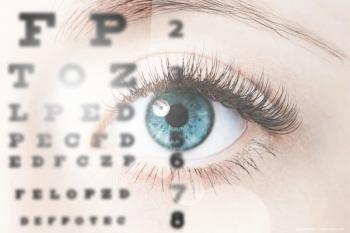
CK corrects hyperopia, astigmatism after laser surgery
Newark, NJ—Conductive keratoplasty (CK) is a safe and effective procedure to treat patients with LASIK complications, an off-label application of the procedure, in whom an additional laser procedure is contraindicated, said Peter Hersh, MD.
He has performed 28 CK procedures on 16 eyes that required rehabilitative surgeries after a refractive procedure.
"The cases that we treated were not typical enhancements after LASIK or PRK, but rather they were cases that had complications, such as excessive flap manipulation, suboptimal flaps, thin flaps, flap striae, surface problems, dry eye, or corneal ectasia," Dr. Hersh said. He is director of the Cornea and the Laser Eye Institute-Hersh Vision Group, and professor of ophthalmology, New Jersey Medical School, Newark.
Dr. Hersh believed that additional flap or laser manipulation was contraindicated in this case. When the patient was examined, her refraction was 3.75 D with 5.5 D of oblique cylinder.
During the first CK application, he applied six CK spots, three in each of the flat meridians. Three months postoperatively, there was some regression, and the procedure was repeated using four spots-two each in the flat meridians-with a smaller optical zone size. The patient response was good; 1 month after the procedure the refraction was almost spherical.
Despite a bit of regression over the following year, the patient was happy with the results, according to Dr. Hersh.
He reported 28 such CK procedures on 16 eyes. The mean patient age was 51 years and the mean follow-up time was 2 to 3 months. These patients received an average of 15 CK spots (range, four to 26 spots).
"The average preoperative uncorrected visual acuity in these patients was 20/68. Postoperatively, the uncorrected visual acuity improved to 20/37," Dr. Hersh said. "The average best-corrected visual acuity generally remained the same from preoperatively to postoperatively; there was an average loss of a half line of vision.
"As expected with CK, there was a hyperopic correction; similarly, there also was a good cylindrical correction," he continued. "In fact, the mean uncorrected visual acuity change in these complicated cases was two lines of increased spectacle-corrected visual acuity, and in two patients the increase was six and nine lines. One patient had overcorrection and lost six lines of uncorrected visual acuity."
Because of these results, Dr. Hersh believes that CK is a useful treatment for these complicated cases.
"CK after complicated laser surgery appears to be effective for hyperopic and astigmatic correction," Dr. Hersh added. "Performing CK does not require recutting the flap, manipulating the flap, or further thinning the cornea. Loss of spectacle-corrected visual acuity is rare.
"I think this procedure is appropriate to consider in patients with hyperopia or mixed astigmatism when there are thin corneas or thin or suboptimal flaps, or in patients who have dry eye or surface epithelial problems," he concluded.
Newsletter
Don’t miss out—get Ophthalmology Times updates on the latest clinical advancements and expert interviews, straight to your inbox.















































.png)


